The Spirit of St Louis (film)
7.2 /10 1 Votes
Initial DVD release August 15, 2006 Duration Country United States | 7.2/10 IMDb Genre Adventure, Biography, Drama Budget 6 million USD Language English | |||||||||||||||||||||||||||||||||
 | ||||||||||||||||||||||||||||||||||
Release date April 20, 1957 (1957-04-20) Cast (Charles Augustus 'Slim' Lindbergh), (Bud Gurney), (Mirror Girl), Bartlett Robinson (Benjamin Frank Mahoney, President Ryan Airlines Co.), (Father Hussman), (Donald Hall, Chief Engineer Ryan Airlines)Similar movies Cast Away , The Wolf of Wall Street , Independence Day , The Grey , Goodfellas , Unbroken Tagline One of the Great Advnetures of Our Time ! | ||||||||||||||||||||||||||||||||||
The spirit of st louis 1957
The Spirit of St. Louis is a 1957 aviation biography film in CinemaScope from Warner Bros., directed by Billy Wilder, produced by Leland Hayward, that stars James Stewart as Charles Lindbergh. The screenplay was adapted by Charles Lederer, Wendell Mayes, and Billy Wilder from Lindbergh's 1953 autobiographical account of his historic flight, which won the Pulitzer Prize in 1954.
Contents
- The spirit of st louis 1957
- The spirit of st louis 1957 official trailer jimmy stewart murray hamilton movie hd
- Plot
- Production
- Reception
- Awards and honors
- References

Along with reminiscences of his early days in aviation, the film's storyline largely focuses on Lindbergh's lengthy preparation for and finally his history-making transatlantic flight in the purpose-built Spirit of St. Louis high-wing monoplane. His take off begins at Roosevelt Field and ends 33-hours later on May 21, 1927 when he lands safely at Le Bourget Field in Paris. The film ends with actual newsreel footage of Lindbergh's ticker tape parade in New York.
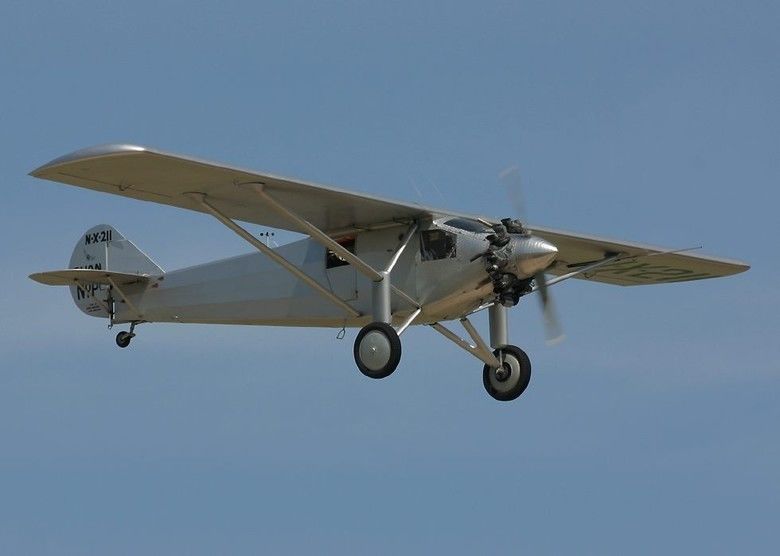
The spirit of st louis 1957 official trailer jimmy stewart murray hamilton movie hd
Plot

On May 19, 1927, after waiting for a week for the rain to stop, pilot Charles A. "Slim" Lindbergh (James Stewart) tries to rest in a hotel near Roosevelt Field on Long Island, New York, prior to a transatlantic flight from New York to Paris. His friend Frank Mahoney (Bartlett Robinson) guards his hotel room door from reporters. Unable to sleep, Lindbergh reminisces about his time as an airmail pilot.
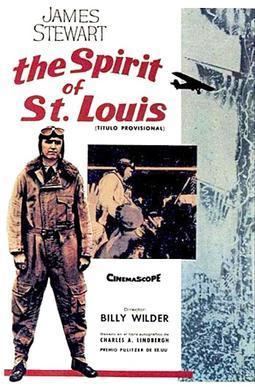
Flying to Chicago in winter, "Slim" lands his old de Havilland biplane at a small airfield to refuel. Despite bad weather, he takes off, unaware heavy snow closed the Chicago landing field. Lindbergh bails out after running out of fuel in the storm. Recovering mail from the crashed DH-4, he continues his journey by train. A salesman tells him two airmen just died competing for the Orteig Prize for the first nonstop flight from New York City to Paris.
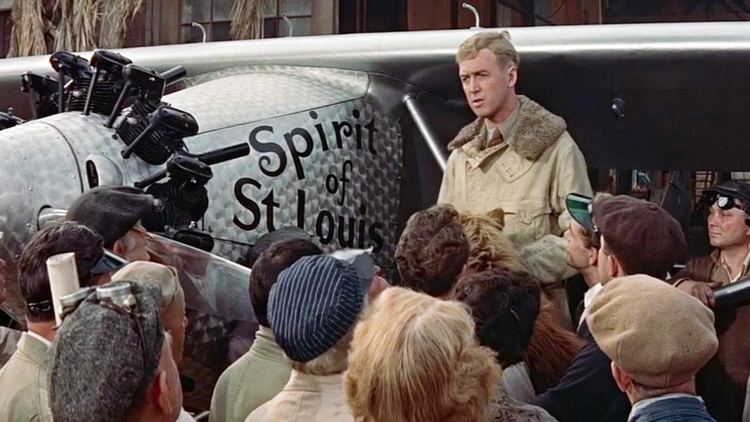
Lindbergh calls Columbia Aircraft Corporation in New York, from a diner in St Louis, pretending to represent a group of prominent businessmen. Quoted a price of $15,000 (equal to $206,810 today) for a Bellanca high-wing monoplane, "Slim" lobbies St. Louis financiers with a plan to fly 40 hours in a stripped-down, single-engine aircraft. The backers are excited by Lindbergh's vision and dub the venture Spirit of St. Louis.

The Bellanca deal falls apart when the company president insists their pilot must make the flight. Lindbergh approaches Ryan Aeronautical Company in San Diego, California. Mahoney, the company president, promises to build a suitable aircraft in just 90 days. With Ryan's chief engineer Donald Hall (Arthur Space), a design takes shape. To decrease weight, "Slim" refuses to install a radio or other heavy equipment, even a parachute, and plans to navigate by "dead reckoning". . As the plane has no autopilot function the pilot cannot sleep during the flight. Workers at the factory agree to work around-the-clock to complete the monoplane in less than 90 days.
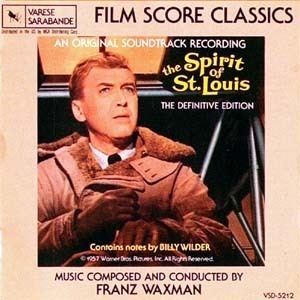
Lindbergh flies the new aircraft to St. Louis and then on to New York. He prepares The Spirit of St. Louis at Roosevelt Field, Long Island, ensuring that 450 gallons of fuel is on board for the trans-Atlantic flight. In the cramped cockpit, which does not allow direct forward view, the magnetic compass must fit above his head, so a young woman offers her compact mirror. "Slim" has the mirror stuck to the instrument panel with chewing gum, so he can read the compass. Furtively, Mahoney slips a Saint Christopher medal into a bag of sandwiches on board.
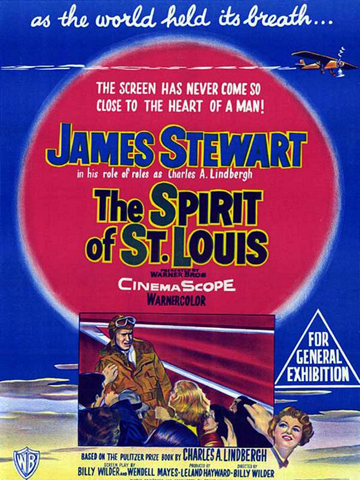
As the weather clears, The Spirit trundles down the muddy runway and barely clears some electric lines and treetops. Media attention is considerable and an American newspapers headline reads: "Lindy Is Off!". Every hour, Lindbergh switches fuel tanks to keep weight balanced. As he flies over Cape Cod, he realizes he has not slept in 28 hours. He recalls past times when he slept on railroad tracks, short bunk beds, and under a windmill. When "Slim" begins to doze, he is awakened by a fly. Over Nova Scotia, he sees a motorcyclist below, remembering his own Harley Davidson motorcycle traded in as partial payment for his first aircraft, a World War I war-surplus Curtiss Jenny.
Over the seemingly endless Atlantic, Lindbergh remembers barnstorming across the Midwest in a flying circus. He flies over an iceberg. After 18 hours, the aircraft's wings and engine begin icing up, and The Spirit of St. Louis begins losing altitude. The ice breaks off in warmer air and the engine is restarted. Back on course, his compasses begin malfunctioning, forcing him to navigate by the stars. By dawn, "Slim" falls asleep, and The Spirit, without an autopilot fitted, descends in a wide spiral toward the ocean. Sunlight reflecting off the compact's mirror finally awakens him in time to regain flight control.
Seeing a seagull, Lindbergh realizes he is close to land. He tries without success to hail a fisherman below. Sighting land, he realizes he has reached Dingle Bay, Ireland. Pulling out a sandwich from the bag, "Slim" discovers the hidden Saint Christopher medal, and hangs it on the instrument panel. Crossing the English Channel and the coast of France, Lindbergh follows the Seine up to Paris as darkness falls. Finally seeing the city lights ahead of him, "Slim" approaches Le Bourget Airfield in the dark, becoming disoriented by panning spotlights aimed into the sky. He glimpses strange movements and lights below, in reality huge crowds of people and traffic in and around Le Bourget. Confused by this chaos, Lindbergh begins his landing approach, quickly becoming panicked. As he goes lower, he whispers "Oh, God, help me!" Landing safely and bringing The Spirit to a full stop, hordes of people rush his aircraft. As flash photography ignites Lindbergh is carried triumphantly on people's shoulders toward a hangar. Exhausted from no sleep, "Slim" eventually realizes the crowds, numbering 200,000, are cheering him and his achievement. On returning to New York City, Lindbergh is given a huge ticker tape parade in his honor, with four million people, having become a national hero.
Production
When production began in August 1955, Jack Warner offered the role to John Kerr, who turned it down. Numerous sources indicate that Stewart was lobbying Warner Bros. executives for the role of Lindbergh as early as 1954. At age 47 when the film was shot, Stewart even underwent a strenuous diet and regimen to look more like the real 25-year-old Lindbergh of 1927. Stewart (with hair dyed blond) was ultimately cast as Lindbergh, but his age was pointedly an issue in post-production reviews. Stewart had a lifelong passion about Lindbergh and aviation. Later in his life, he said the "Lone Eagle"'s flight was one of the most significant episodes of his youth, leading him to seek a career as an aviator. Like Lindbergh, Stewart had been an USAAF pilot, and both eventually retired from the U.S. Air Force Reserve at the grade of Brigadier General.
In order to accurately depict the transatlantic flight, three replicas, at a cost of $1.3 million (equal to $11,622,484 today), were made of the Spirit of St. Louis for the various filming units stateside, in Europe, and for in-studio shots. A similar Ryan Brougham was bought by Stewart and modified with Lindbergh's supervision. It was donated to the Henry Ford Museum in Dearborn, Michigan by Stewart in 1959. The third replica is displayed in the Missouri History Museum in St. Louis. Filming took place at the Santa Maria Public Airport in Santa Maria, California, at what is currently the site of Allan Hancock College. A non-flying replica for ground shots was also built, and hangs in the Minneapolis−Saint Paul International Airport. Aerial sequences were directed by Paul Mantz and taken from a North American B-25 bomber converted as camera platform for photography.
In order to begin work, a small pre-production crew was sent in August 1955 to New York, to film at Roosevelt Field in Long Island, and later, aerial sequences over the Appalachian Mountains in Nova Scotia and at St. John's, Newfoundland, recreating the initial stages of the transatlantic flight. Principal photography began on September 2, 1955, with filming taking place at L'aérodrome de Guyancourt, near Versailles, which would stand-in for le Bourget. Difficulties with Stewart's schedule led to the abandoning of aerial sequences that had been planned with the veteran pilot actually flying one of the replicas over European locales. Ultimately, staged scenes using a mock-up on a sound stage had to suffice. The film's schedule was disrupted throughout the fall and only resumed in November when Stewart had completed two other films. The original 64-day schedule ballooned into a 115-day marathon, as weather and the star's unavailability hampered the production, with final sequences shot in March 1956.
Aaron Spelling appears as Mr. Fearless in an uncredited role that marks an early foray into acting.
Reception
Previews had not been promising, and when released in April 1957, after being in production for 20 months, The Spirit of St. Louis was a box-office failure mainly due to its huge budget (running at $6 million, more than twice the original budget). Garnering mixed reviews, with Bosley Crowther at The New York Times praising the "... exciting and suspenseful episodes" while noting Stewart's performance as Lindbergh did not convey the human side well. "We see very little of his basic nature, his home life or what makes him tick. As Mr. Stewart plays him, with his usual diffidence, he is mainly a type. That's too bad, for after all these years of waiting, it would be interesting if we could see what it was about the fellow that made him uniquely destined for his historic role." However, the film was commended for its special effects and James Stewart’s competent performance. In 1957, Time magazine described the film in these words, "Stewart, for all his professional, 48-year-old boyishness, succeeds almost continuously in suggesting what all the world sensed at the time: that Lindbergh's flight was not the mere physical adventure of a rash young 'flying fool' but rather a journey of the spirit, in which, as in the pattern of all progress, one brave man proved himself for all mankind as the paraclete of a new possibility."
In recent years, the film has regained some of its lustre and a modern reevaluation has centered on the characterization of Lindbergh and the methodical depiction of the preparations for the momentous flight. The Smithsonian Institution has recently screened the film as part of its "classic" series and the DVD rerelease in 2006, with remixed and digitized elements and a small number of special features, has evoked commentary such as "captivating" and "suspenseful."
Awards and honors
At the 1958 Academy Awards, Louis Lichtenfield earned a nomination for Best Special Effects.
References
The Spirit of St. Louis (film) WikipediaThe Spirit of St. Louis (film) IMDb The Spirit of St Louis (film) themoviedb.org
